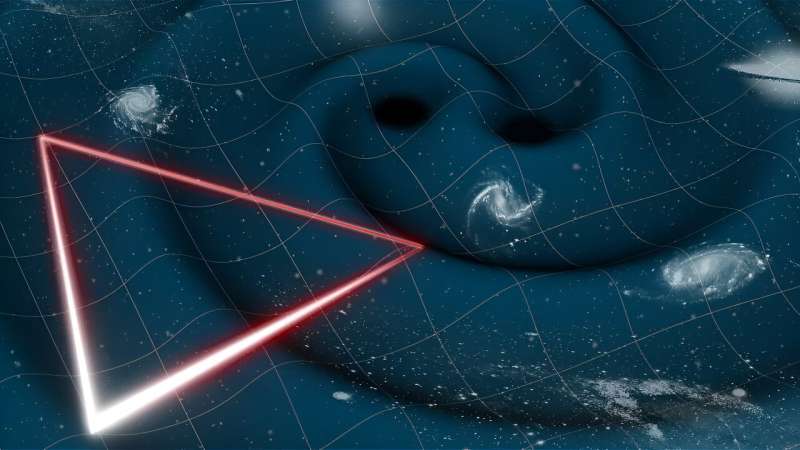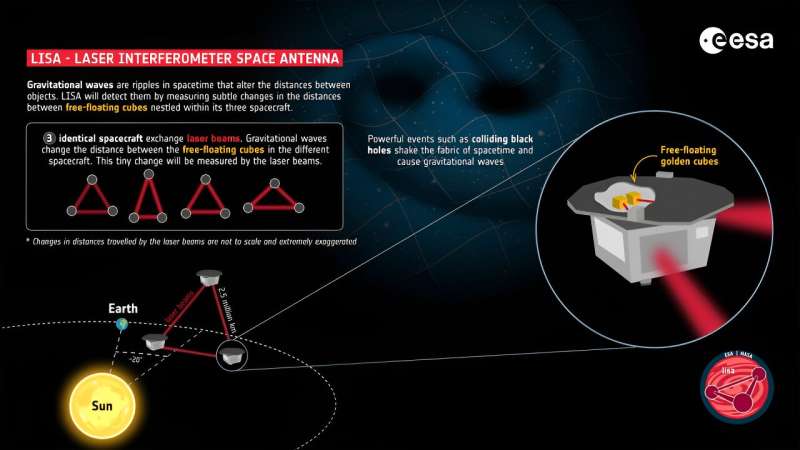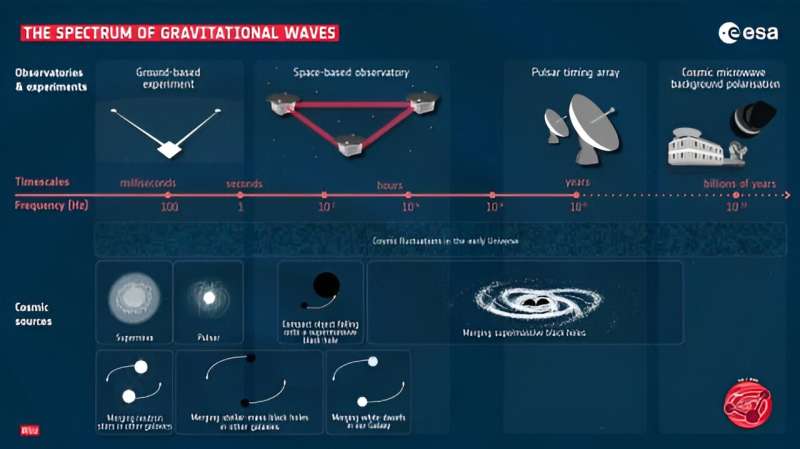This article has been reviewed according to Science X's editorial process and policies. Editors have highlighted the following attributes while ensuring the content's credibility:
fact-checked
trusted source
proofread
The space-based gravitational wave observatory LISA gets the green light

The science of studying gravitational waves just got a big boost thanks to the European Space Agency. Its science program committee just approved the Laser Interferometer Space Antenna—affectionately known as LISA—for official planning and building. That means gravitational wave astronomers will take their next steps to capture information about gravity waves from space.
LISA—or something like it—has been on the drawing boards since the 1980s. The current LISA observatory was proposed about a decade later and scientists flew a "pathfinder mission" to test out its principal design. Now, it's going to be a full-fledged set of three spacecraft set to launch in 2035 and should revolutionize gravitational wave studies.
The spacecraft constellation will maneuver into three separate positions in an Earth-like heliocentric orbit. Essentially, they'll form a triangle, joined together by laser beams that will each shoot across 2.5 million kilometers of space. Those beams will be the prime gravitational wave detectors. When a wave passes by, it will change the length of each laser "arm."
Sophisticated instruments onboard will record the changes and send that data back to Earth for analysis. The differential changes in the length of each arm will tell scientists crucial information about the objects that collided to create the waves. If all goes well, LISA will become the first space-based observatory dedicated solely to these ripples in the fabric of spacetime.

The next steps
The decision to forge ahead with LISA is a formal step called "adoption." It basically says that the technology for the mission and the concept and timeline are good to go. That allows the agency to go ahead with building the spacecraft and its instrumentation. From this point, the agency is now free to solicit and select contractors for fabrication. The design and assembly process could begin as early as January 2025.
LISA's development won't be easy, according to lead project scientist Nora Lützgendorf. "LISA is an endeavor that has never been tried before," she said. "Using laser beams over distances of several kilometers, ground-based instrumentation can detect gravitational waves coming from events involving star-sized objects—such as supernova explosions or merging of hyper-dense stars and stellar-mass black holes. To expand the frontier of gravitational studies we must go to space. Thanks to the huge distance traveled by the laser signals on LISA, and the superb stability of its instrumentation, we will probe gravitational waves of lower frequencies than is possible on Earth, uncovering events of a different scale, all the way back to the dawn of time."

Protecting LISA from outside influences in space
Of course, space presents unique challenges to the spacecraft's mission. In that regard, LISA faces some similar types of issues that LIGO and others meet on the ground. For example, the ground rumbles from heavy trucks driving by disturb the LIGO instruments. That means its scientists have to filter out any non-gravitational-wave disturbances.
There aren't trucks in space, thankfully, but LISA will face some non-gravitational-wave forces such as light pressure and the solar wind. Scientists will get around those with some very clever spacecraft designs. Each of the three craft will be equipped with telescopes, lasers, and test masses made of gold-coated gold and platinum.
To protect the test masses from outside influences (which can "push around" the masses), they will float freely inside the spacecraft. The outer hulls of the craft will absorb the outside influences. Thrusters will adjust the spacecraft in position and keep the masses from experiencing anything except the target gravitational waves. The result should be a very "clean" capture of gravitational wave data from distant objects and events in the universe.
LISA's gravitational wave targets
This intricate mission should be able to capture the ripples in spacetime produced when massive objects collide. That includes the mergers of supermassive black holes at the hearts of galaxies. In our own galaxy, LISA should be able to detect the mergers of white dwarfs or neutron stars. Its data should give astronomers precise information about the distances to these events and even their locations.
"For centuries we have been studying our cosmos through capturing light. Coupling this with the detection of gravitational waves is bringing a totally new dimension to our perception of the universe," said LISA project scientist Oliver Jennrich. "If we imagine that, so far, with our astrophysics missions, we have been watching the cosmos like a silent movie, capturing the ripples of spacetime with LISA will be a real game-changer, like when sound was added to motion pictures."
One very exciting possibility that LISA could enable is the detection of the very first seconds after the Big Bang occurred. That's because gravitational waves from that seminal event will carry distance and intensity information. Not only that, but LISA data will also help astronomers measure the expansion rate of the universe throughout time. If all this comes to pass, it will prove the usefulness of gravitational waves as a unique way of measuring things in the cosmos.
Provided by Universe Today

















